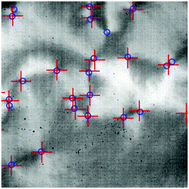当前位置:
X-MOL 学术
›
Soft Matter
›
论文详情
Our official English website, www.x-mol.net, welcomes your
feedback! (Note: you will need to create a separate account there.)
End-to-end machine learning for experimental physics: using simulated data to train a neural network for object detection in video microscopy.
Soft Matter ( IF 2.9 ) Pub Date : 2020-01-07 , DOI: 10.1039/c9sm01979k Eric N Minor 1 , Stian D Howard , Adam A S Green , Matthew A Glaser , Cheol S Park , Noel A Clark
Soft Matter ( IF 2.9 ) Pub Date : 2020-01-07 , DOI: 10.1039/c9sm01979k Eric N Minor 1 , Stian D Howard , Adam A S Green , Matthew A Glaser , Cheol S Park , Noel A Clark
Affiliation

|
We demonstrate a method for training a convolutional neural network with simulated images for usage on real-world experimental data. Modern machine learning methods require large, robust training data sets to generate accurate predictions. Generating these large training sets requires a significant up-front time investment that is often impractical for small-scale applications. Here we demonstrate a 'full-stack' computational solution, where the training data set is generated on-the-fly using a noise injection process to produce simulated data characteristic of the experimental system. We demonstrate the power of this full-stack approach by applying it to the study of topological defect annihilation in systems of liquid crystal freely-suspended films. This specific experimental system requires accurate observations of both the spatial distribution of the defects and the total number of defects, making it an ideal system for testing the robustness of the trained network. The fully trained network was found to be comparable in accuracy to human hand-annotation, with four-orders of magnitude improvement in time efficiency.
中文翻译:

实验物理的端到端机器学习:使用模拟数据训练神经网络以进行视频显微镜中的目标检测。
我们演示了一种使用模拟图像训练卷积神经网络以用于实际实验数据的方法。现代机器学习方法需要庞大而强大的训练数据集,以生成准确的预测。生成这些大型培训集需要大量的前期投入,这对于小规模的应用程序通常是不切实际的。在这里,我们演示了一种“全栈”计算解决方案,其中使用噪声注入过程动态生成训练数据集,以产生实验系统的模拟数据特征。我们通过将其应用于液晶自由悬浮薄膜系统中的拓扑缺陷an灭研究,证明了这种全堆叠方法的强大功能。这个特定的实验系统需要对缺陷的空间分布和缺陷总数进行准确的观察,从而使其成为测试训练网络的鲁棒性的理想系统。发现经过充分训练的网络在准确性上可与人工注释相媲美,时间效率提高了四个数量级。
更新日期:2020-02-19
中文翻译:

实验物理的端到端机器学习:使用模拟数据训练神经网络以进行视频显微镜中的目标检测。
我们演示了一种使用模拟图像训练卷积神经网络以用于实际实验数据的方法。现代机器学习方法需要庞大而强大的训练数据集,以生成准确的预测。生成这些大型培训集需要大量的前期投入,这对于小规模的应用程序通常是不切实际的。在这里,我们演示了一种“全栈”计算解决方案,其中使用噪声注入过程动态生成训练数据集,以产生实验系统的模拟数据特征。我们通过将其应用于液晶自由悬浮薄膜系统中的拓扑缺陷an灭研究,证明了这种全堆叠方法的强大功能。这个特定的实验系统需要对缺陷的空间分布和缺陷总数进行准确的观察,从而使其成为测试训练网络的鲁棒性的理想系统。发现经过充分训练的网络在准确性上可与人工注释相媲美,时间效率提高了四个数量级。











































 京公网安备 11010802027423号
京公网安备 11010802027423号